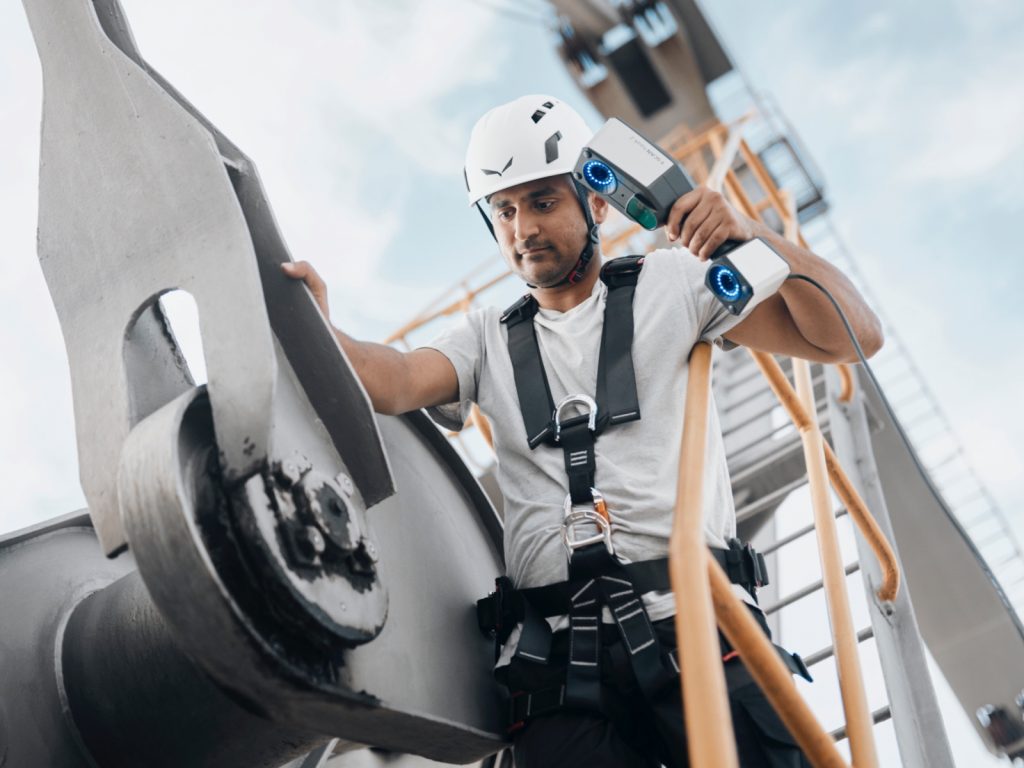How does optical metrology work?
Optical metrology works by using light to interact with the object being measured, and then measuring the characteristics of the light that is reflected, refracted and transmitted, or absorbed by the object. This can include using interferometry, speckle pattern analysis, or laser structured light patterns to measure properties, such as distance, shape, or surface roughness.
Interferometry involves using two or more beams of light to create an interference pattern that can be used to measure the distance between the object and the measuring device. Speckle pattern analysis uses the way light is scattered by a rough surface to determine surface roughness. Structured light patterns or laser lines are projected onto the part to create 3D maps of an object’s shape by deflection of the pattern or laser line.
Applications of optical metrology
This measuring technology can be used in a wide range of applications like:
1. Manufacturing and Engineering
Optical metrology is used in manufacturing and engineering to ensure the quality and accuracy of parts and components. This can include measuring the dimensions and surface roughness of machined parts, as well as monitoring the quality of coatings and other surface treatments.
MMG: Meet the world’s largest ship propellers
Meet MMG and their impressive ship propellers. Although huge, the parts are planned to the detail before months of development culminate in about ten minutes of casting time. To ensure quality and functionality, 3D measurement plays an import role in the process. Be ready for a big story.
Our Maker Portraits are behind-the-scenes looks at some of the most exciting manufacturing, maintenance and repair service workshops. Do you want to learn more about MMG? Visit www.xxl-metalworking.com
2. Biomedical and Life Sciences
Optical metrology is used in biomedical and life sciences to measure and analyze the physical properties of cells, tissues, and organs. This can include measuring cell size and shape, as well as the surface roughness of biological materials.
3. Archaeology and Conservation
Optical metrology is used in archaeology and conservation to accurately measure and document cultural heritage objects. This can include creating 3D models of artifacts, as well as monitoring changes in the condition of historic buildings and monuments.
Museum of Research Schöningen: Archeology meets 3D scan technology
300.000 years of history are archived at the Museum of Research in Schöningen. 3D metrology solutions help to collect detailed information about the findings. Whether the reconstruction of parts or precise surface inspection: Thus the GOM Scan 1 and the software solution allow an insight into the past, which is accessible to everyone. Learn more about the Museum: https://forschungsmuseum-schoeningen.de/home
4. Aerospace and Defense
Optical metrology is used in the aerospace and defense industries to measure the shape and surface quality of parts and components. This can include measuring the curvature of mirrors and lenses, as well as the surface roughness of radar-absorbing materials.
Advantages and disadvantages of optical metrology
Optical metrology is a non-contact measurement technique, meaning that there is no physical contact between the measuring device and the object being measured. This can help to minimize the risk of damage to the object or part. In addition, optical measuring methods can provide highly accurate measurements, making it a valuable tool for applications that require precise measurements. The speed of this technology furthermore speaks for the use of it. Optical metrology can provide measurements quickly, making it a valuable tool for applications that require rapid measurements.
However, like every technology, the optical method of measurement got some disadvantages you have to know about.
Optical metrology can be sensitive to changes in the environment, such as temperature, humidity, and vibration. This can make it more difficult to achieve accurate and consistent measurements in certain conditions. Moreover, optical metrology may have limited range, depending on the specific method used. This can make it more difficult to measure large objects or surfaces. Furthermore, optical measuring methods and the necessary equipment can be expensive, which can make it less accessible for some applications or industries.
The perfect fit for you
ZEISS optical metrology solutions help to minimize the disadvantages by finding the right device for your inspection task. Whether it’s the use in the production area, the inspection of different parts or parts sizes – there is most certainly a solution for you.

Overall, optical metrology is a powerful measurement technique that uses light to gather data about the physical properties of objects. Its wide range of applications and high accuracy make it a valuable tool in various industries and fields – from manufacturing and engineering to biomedical and life sciences. While there are some limitations to optical metrology, with our solution we minimize these limitations, and maximize the advantages to make it a valuable tool for many applications.
